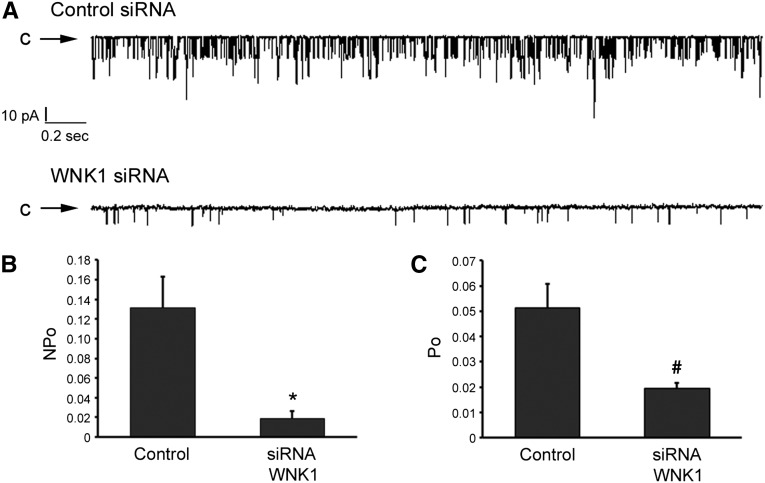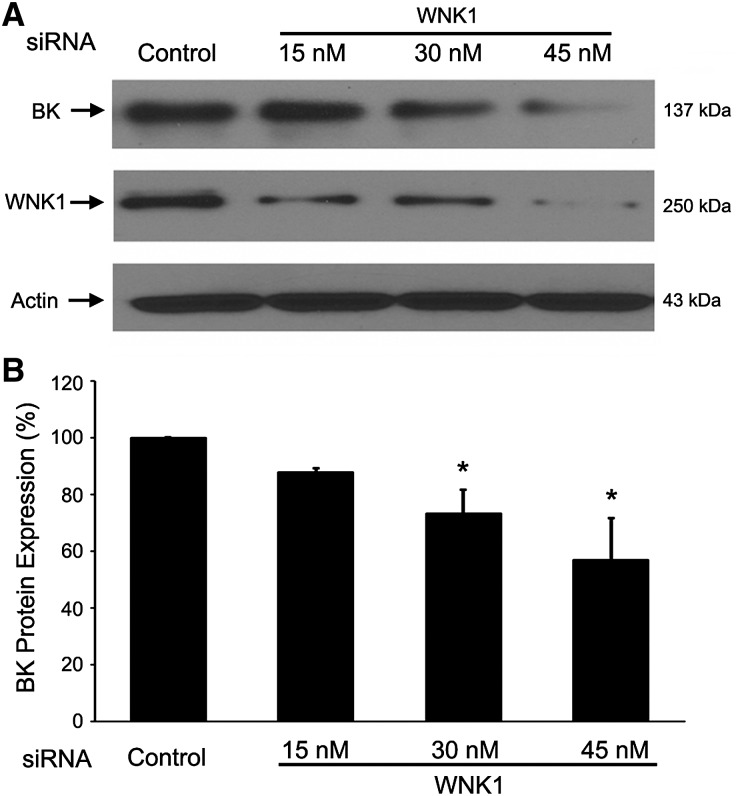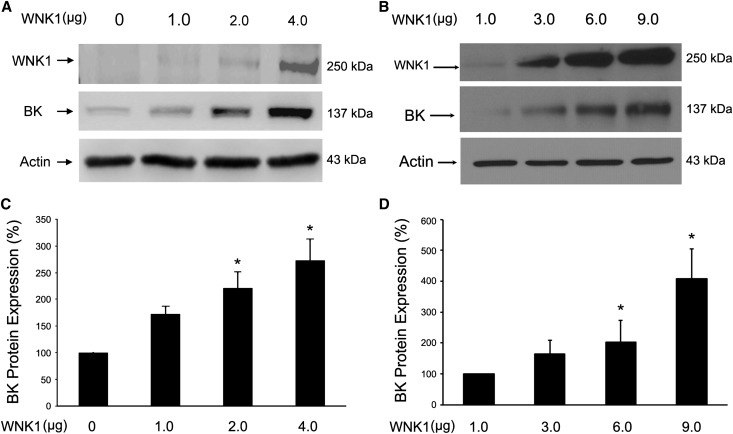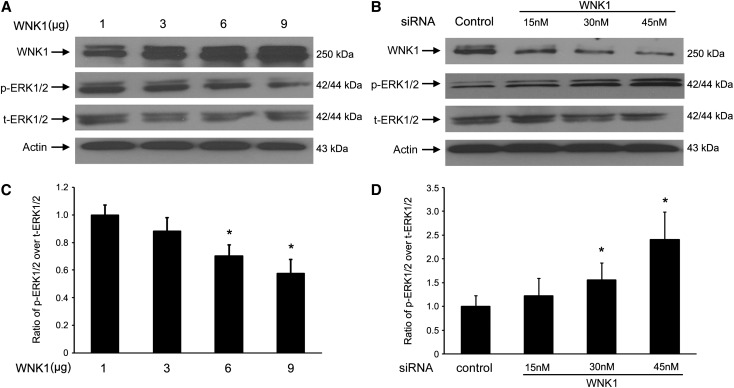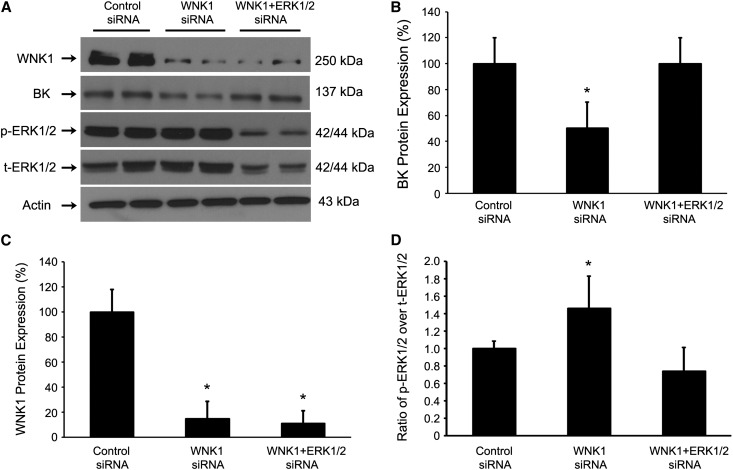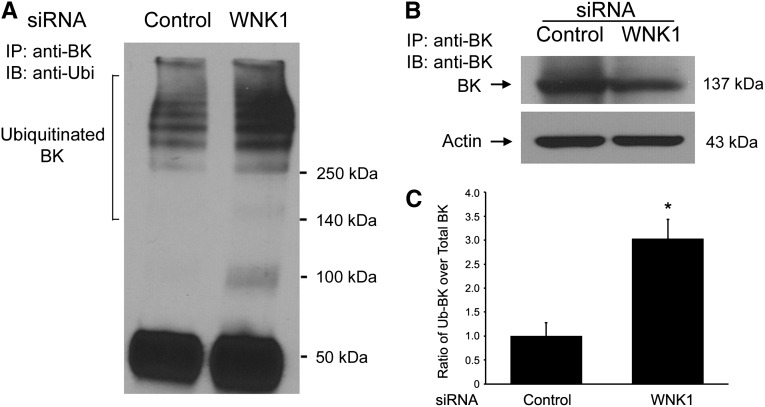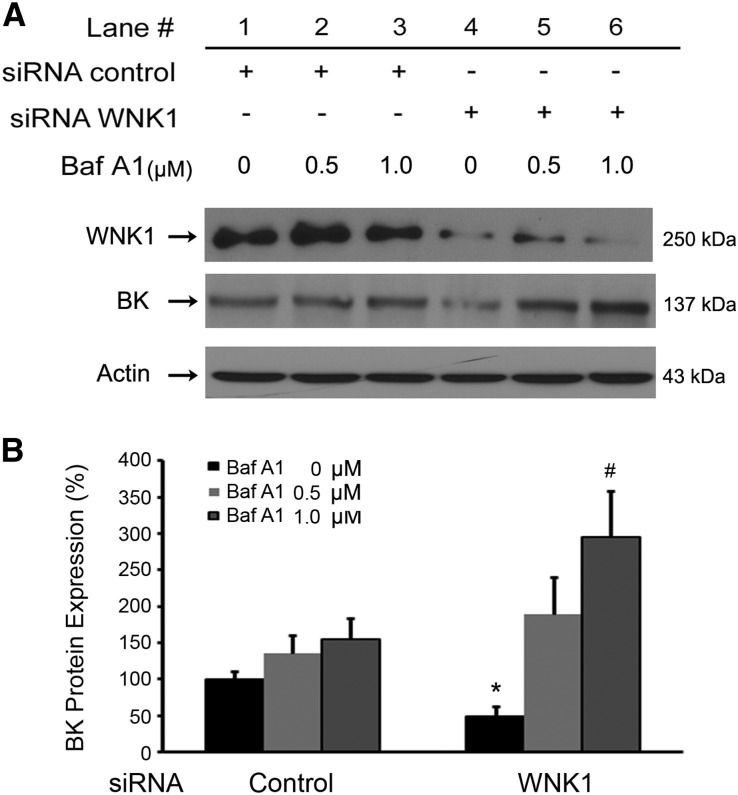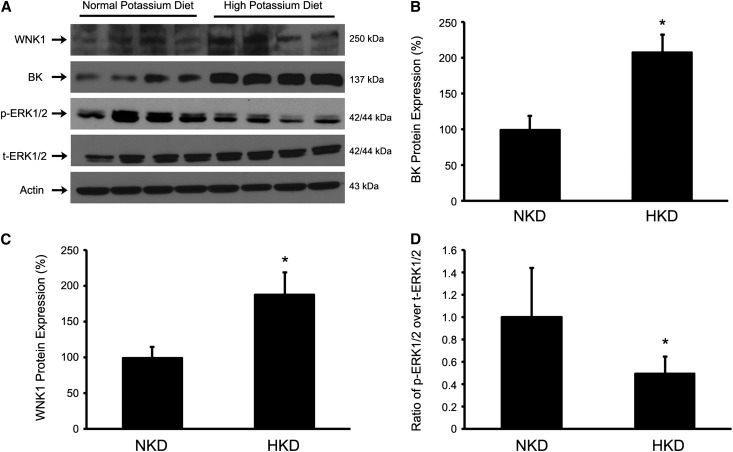Abstract
With no lysine (WNK) kinases are members of the serine/threonine kinase family. We previously showed that WNK4 inhibits renal large-conductance Ca2+-activated K+ (BK) channel activity by enhancing its degradation through a lysosomal pathway. In this study, we investigated the effect of WNK1 on BK channel activity. In HEK293 cells stably expressing the α subunit of BK (HEK-BKα cells), siRNA-mediated knockdown of WNK1 expression significantly inhibited both BKα channel activity and open probability. Knockdown of WNK1 expression also significantly inhibited BKα protein expression and increased ERK1/2 phosphorylation, whereas overexpression of WNK1 significantly enhanced BKα expression and decreased ERK1/2 phosphorylation in a dose-dependent manner in HEK293 cells. Knockdown of ERK1/2 prevented WNK1 siRNA-mediated inhibition of BKα expression. Similarly, pretreatment of HEK-BKα cells with the lysosomal inhibitor bafilomycin A1 reversed the inhibitory effects of WNK1 siRNA on BKα expression in a dose-dependent manner. Knockdown of WNK1 expression also increased the ubiquitination of BKα channels. Notably, mice fed a high-K+ diet for 10 days had significantly higher renal protein expression levels of BKα and WNK1 and lower levels of ERK1/2 phosphorylation compared with mice fed a normal-K+ diet. These data suggest that WNK1 enhances BK channel function by reducing ERK1/2 signaling-mediated lysosomal degradation of the channel.
Keywords: Cell and transport physiology, cell signaling, K channels
With no lysine (WNK) kinase belongs to a family of serine/threonine kinases. Mutations of WNK1 and WNK4 are responsible for pseudohypoaldosteronism type II (PHAІІ), characterized by hypertension, hyperkalemia, and metabolic acidosis.1,2 The disease mutation in WNK1 or WNK4 kinase resulting in hyperkalemia suggests a role of WNK in potassium handling in renal distal nephron, which contains two major potassium channels, renal outer medullary K+ channels (ROMK) and Big K (BK) channels.3,4 WNK4 inhibits ROMK channel activity and its surface expression, whereas WNK4 disease mutant enhances its inhibitory effect on ROMK.5 WNK1 also inhibits ROMK activity; however, a kidney-specific form of WNK1 (KS-WNK1) reverses WNK1’s effect on ROMK.6 WNK4 inhibits BK channel activity and protein expression,7–9 whereas WNK4 disease mutant also enhances its inhibitory effect on BK activity via a ubiquitin-dependent pathway.9
BK channel (or Maxi K) is a large conductance Ca2+ and voltage-activated K channel.10 BK is encoded by the gene slo111 and is widely distributed in many different tissues.12 BK channels are composed of two subunits: a pore-forming α subunit and a modulatory β subunit.13 The α subunit of BK (BKα) channels functions as a channel by itself and is modulated by cAMP-dependent protein kinase A,14–16 protein kinase C,14,16–18 cGMP-dependent PKG,17,19 and cSrc.20 It is also regulated extensively by alternative splicing,21 phosphorylation and dephosphorylation,22 and associated regulatory β subunits.23 The β subunits alter the apparent Ca2+ and voltage sensitivity of the α subunit, modify channel kinetics, and alter the pharmacologic properties of the channel.24 The β1 subunit rapidly traffics to surface membrane to associate with BKα and control functional BK activity in response to nitric oxide stimulation.25 BKα is expressed in various renal tubular segments, including medullary and cortical thick ascending limbs,26 distal convoluted tubule,27 connecting tubule,28 principal cells and intercalated cells of the cortical collecting duct (CCD).29 BK channel is responsible for the flow-dependent K+ secretion in CCD.30 Inhibition of mitogen-activated protein kinase (MAPK) stimulates BK activity in CCD cells.31 Our previous study showed that WNK4 inhibits BK channel activity by enhancing its degradation via a lysosomal pathway.7 WNK4 inhibits BK activity by activating extracellular signal-regulated kinase 1/2 (ERK1/2) and p-38 signaling pathways.8 WNK1 phosphorylates ERK5 via MEKK2/3.32 However, little is known about the effect of WNK1 kinase on BK activity and ERK1/2 signaling pathway. Here, we report that the knockdown of WNK1 expression significantly inhibited both BKα NPo and its open probability. Knockdown of WNK1 expression significantly inhibited BKα protein expression, which was reversed by bafilomycin A1, a lysosomal inhibitor, and overexpressing WNK1 significantly enhanced BKα protein expression. Overexpressing WNK1 also decreased ERK1/2 phosphorylation, whereas WNK1 knockdown increased ERK1/2 phosphorylation. Knocking down ERK1/2 abolished the small interfering RNA (siRNA) WNK1-mediated inhibitory effect on BKα expression. The knockdown of WNK1 expression reduced BKα while increasing BKα ubiquitination. In vivo mice study showed that protein abundances of BKα and WNK1 were significantly higher in mice fed with a high-K diet while reducing ERK1/2 phosphorylation. These data suggest that WNK1 activates BK channel activity by reducing BK degradation through a lysosomal pathway via ERK1/2-dependent signaling.
Results
Effect of WNK1 on BK Channel Activity
To determine whether WNK1 affects the activity of BK channel, a single-channel recording using a cell-attached technique was performed in human embryonic kidney 293 (HEK293) BKα stably expressing cells (HEK BKα cells) transfected with siRNA WNK1 (45 nM) or scramble siRNA control. As shown in Figure 1, knocking down WNK1 expression significantly inhibited both BKα NPo (0.0192±0.0074, n=18 versus 0.1316±0.0311 in control group, n=36; P=0.006) and open probability (Po; 0.0194±0.0023 versus 0.0512±0.0096 in control group; P<0.001). These data suggest that WNK1 activates BK channel activity.
Figure 1.
Knockdown of WNK1 expression inhibits BKα channel activity in HEK293 stably expressing cells (HEK BKα cells). HEK BKα cells were transfected with siRNA WNK1 (45 nM) or scramble control siRNA. Single cell recordings using a cell-attached configuration were performed 48 hours after transfection. (A) The representative recording traces for both siRNA WNK1 and scramble control siRNA groups at a hold potential of −40 mV. (B) Bar graph for BKα channel NPo. (C) Bar graph for BK Po. Knockdown of WNK1 expression significantly inhibits both BKα channel NPo (0.0192±0.0074 in siRNA WNK1, n=18, compared with the siRNA control group, 0.1316±0.0311, n=36; *P=0.006) and Po (0.0194±0.0023, compared with the siRNA control group, 0.0512±0.0096; #P<0.001).
Effect of WNK1 on BK Protein Expression
Because WNK1 activates BK channel activity, likely by increasing the channel number, we investigated whether WNK1 affects BK protein expression, which could be responsible for increased BK activity. First, we determined the effect of siRNA WNK1 on BK protein expression in HEK BKα cells. As shown in Figure 2, WNK1 expression was markedly decreased by siRNA WNK1, and knockdown of WNK1 expression significantly reduced BK protein expression in a dose-dependent manner (100%±0% with siRNA WNK1 at 0 nM, 87.9%±1.6% at 15 nM, 73.2%±8.5% at 30 nM, 57.1%±29.4% at 45 nM; n=5; P<0.05 compared with WNK1 at 0 nM group), as shown in Figure 2B. We repeated the above knockdown experiment with second siRNA WNK1 (45 nM), knockdown of WNK1 expression also significantly reduced BK protein expression (Supplemental Figure 1).
Figure 2.
Knockdown of WNK1 expression decreases BKα protein expression in HEK BKα cells. HEK BKα cells were transfected with scramble control siRNA or a series of doses of siRNA WNK1. Forty-eight hours after transfection, cells were lysed and subjected to SDS-PAGE and Western blot analysis. (A) Representative immunoblots for BK, WNK1, and actin. (B) Bar graph shows mean±SEM band densities of BK from five independent experiments. Knockdown of WNK1 expression significantly decreases total BK protein expressions in a dose-dependent manner. n=5; *P<0.05 versus control.
We then performed WNK1-overexpressing experiments. As shown in Figure 3, WNK1 overexpression significantly increased BK protein expressions in a dose-dependent manner either in HEK293 cells transfected with myc-BK or in HEK stably expressing BKα cells. WNK1 significantly increased BK protein expression (100%±0% with WNK1 at 0 μg, 172.3%±13.6% at 1 μg, 221.0%±29.2% at 2 μg, and 272.9%±38.5% at 4μg; n=4; P<0.05 compared with WNK1 0-μg group) in both HEK293 cells transiently expressing BK and WNK1 (Figure 3, A and C) and HEK BKα stable cells expressing WNK1 (100%±0% with WNK1 at 1 μg, 164.1%±44.3% at 3 μg, 203.1%±69.6% at 6 μg, 409.0%±121.9% at 9 μg; n=5; P<0.05 compared with WNK1 1-μg group) (Figure 3, B and D). These data suggested that WNK1 significantly increases BK protein expressions, ultimately leading to activating BK activity.
Figure 3.
Overexpression of WNK1 increases BK protein expressions in HEK293 cells with transiently expressing BKα or stably expressing BKα. HEK293 cells were transfected with both pCMV-myc-BKα and a series of doses of pcDNA4.0-his-myc-WNK1 (A) in four independent experiments. HEK BKα cells were transfected with a series of doses of WNK1 in five independent experiments (B). Forty-eight hours after transfection, cells were lysed and subjected to SDS-PAGE and Western blot analysis. (A and B) Representative immunoblots for WNK1, BK, and actin. (C and D) Bar graphs of summarized data from respective immunoblots. Anti-myc antibody was used for detecting WNK1 and BK protein expressions in A. Anti-WNK1 and anti-BK antibodies were used to detect WNK1 and BK protein expressions, respectively, in B. Overexpression of WNK1 both in transiently transfected HEK293 cells and HEK stably expressing BKα cells significantly increased total BK protein expressions in a dose-dependent manner. *P<0.01 compared with the control.
Effect of WNK1 on ERK1/2 Phosphorylation
WNK4 inhibits BK activity by activating ERK1/2 and p-38 signaling pathways.8 We therefore determined whether WNK1 stimulates BK activity and protein expression by inhibiting ERK1/2 signaling pathway. In HEK BKα cells transfected with WNK1, WNK1 overexpression significantly decreased ERK1/2 phosphorylation in a dose-dependent manner (p-ERK1/2/t-ERK1/2 ratio of 1.0±0.07 with WNK1 at 1 μg, 0.88±0.09 at 3 μg, 0.71±0.08 at 6 μg, 0.57±0.10 at 9 μg; n=4; P<0.05 compared with 1-μg WNK1 group) (Figure 4, A and C), whereas knocking down WNK1 expression significantly increased ERK1/2 phosphorylation in a dose-dependent manner (p-ERK1/2/t-ERK1/2 ratio of 1.0±0.22 with siRNA control, 1.22±0.36 with siRNA WNK1 15 nM, 1.56±0.35 at 30 nM, 2.40±0.58; n=4; P<0.05 compared with siRNA control group) as shown in Figure 4, B and D. These data suggested that WNK1 enhances BK channel activity and its protein expression, likely by inhibiting ERK1/2 signaling pathway.
Figure 4.
WNK1 reduces ERK1/2 phosphorylations in HEK BKα cells. HEK BKα cells were transfected with a series of doses of WNK1 plasmids (A) or a series of doses of siRNA WNK1 (B). Forty-eight hours after transfection, cells were lysed and subjected to SDS-PAGE and Western blot analysis. (A and B) Representative immunoblots for WNK1, p-ERK 1/2, t-ERK1/2, and actin. (C and D) Bar graphs show the ratios of p-ERK1/2 to total ERK1/2 from four independent experiments for the respective immunoblot (mean±SD). Overexpression of WNK1 significantly reduces ERK1/2 phosphorylation, whereas knockdown of WNK1 expression significantly enhances ERK1/2 phosphorylation in a dose-dependent manner. n=4; *P<0.05.
Effect of siRNA ERK1/2 on BK Protein Expression
To confirm that WNK1 modulates BK protein expression through the ERK1/2 signaling pathway, we performed ERK1/2 knockdown experiments. In HEK BKα cells transfected with siRNA WNK1 (45 nM) with or without siRNA ERK 1/2, WNK1 expression was significantly reduced by >85% (Figure 5C). BK protein expression was significantly reduced in the siRNA WNK1 transfected group (50.3%±10.2%) compared with siRNA control group (100%±11.7%; n=8; P<0.01), as shown in Figure 5B, while increasing EKR1/2 phosphorylation (p-ERK1/2/t-ERK1/2 ratio of 1.48±0.35 versus 1.0±0.08; n=8; P<0.01) (Figure 5D). However, when in HEK BKα cells cotransfected with both siRNA WNK1 (45 nM) and siRNA ERK1/2 (15 nM), ERK1/2 protein expression and ERK1/2 phosphorylation were remarkably reduced, as expected (Figure 5A). BK protein expression was back to the control level (100.1%±22.8%) (Figure 5B), suggesting that knockdown of ERK1/2 abolished the effect of WNK1 on BK. These data further supported that WNK1 modulates BK through an ERK1/2 signaling-dependent pathway.
Figure 5.
Knockdown of ERK1/2 expression abolished WNK1-mediated effects on BK protein expression. HEK BKα cells were transfected with scramble control siRNA or 45 nM of siRNA WNK1 with or without siRNA ERK1/2 (15 nM). Forty-eight hours after transfection, cells were lysed and subjected to SDS-PAGE and Western blot analysis. (A) Representative immunoblots for WNK1, BK, phospho-ERK1/2, total-ERK1/2, and actin. Bar graphs show mean±SD band densities of BK (B) and WNK1 (C) and ratio of p-ERK1/2 over t-ERK1/2 (D). The knockdown of WNK1 expression significantly decreases total BK protein expressions, whereas knocking down ERK1/2 abolished siRNA WNK1-mediated inhibitory effect on BK protein expressions. n=8; *P<0.05 versus control.
Effect of WNK1 on BK Ubiquitination
Activation of ERK 1/2 signaling increases ubiquitination of the sodium chloride cotransporter, ultimately leading to NCC degradation.33 To determine whether WNK1 affects BK ubiquitination after inhibiting ERK1/2 phosphorylation, we assessed the effect of siRNA WNK1 on BK ubiquitination. As shown in Figure 6, in HEK BKα cells transfected with siRNA WNK1 (45 nM), knockdown of WNK1 markedly reduced total BK protein expression (Figure 6B), whereas knockdown of WNK1 expression significantly increased BK ubiquitination (302.7%±41.0% versus 100%±27.7% in siRNA control group; n=4; P<0.05) (Figure 6C), suggesting that knockdown of WNK1 reduces BK protein levels by increasing BK ubiquitination, ultimately leading to BK degradation.
Figure 6.
Effect of knockdown of WNK1 expression on BK ubiquitination in HEK BKα cells. HEK BKα cells were transfected with scramble control siRNA or siRNA WNK1. Forty-eight hours after transfection, cells were lysed and subjected to SDS-PAGE, Immunoprecipitation, and Western blot analysis. A representative immunoblot of four independent experiments is shown here. (A) Sample was immunoprecipitated with anti-BKα antibody and immunoblotted (IB) with anti-ubiquitin antibody. B. Sample was immunoprecipitated with anti-BKα antibody, and immunoblotting was performed with the same anti-BKα antibody. (C). Bar graph shows summary data of the ratio of ubiquitinated-BK over total BK protein expressions from four independent experiments (mean±SD). Knockdown of WNK1 expression markedly reduces total BK protein expression (B) while significantly increasing BK ubiquitination (A).
WNK1 Stabilizes BK Protein Expression by Reducing Its Degradation through a Lysosomal Pathway
Given the inhibitory effect of WNK1 knockdown on BK protein expression, we further investigated whether knockdown of WNK1 enhances the degradation of BK protein. Thus, we determined the effect of bafilomycin A1 (Baf A1), a lysosomal inhibitor, on BK protein expression. Baf A1 specifically inhibits the vacuolar-type H+-ATPase and thereby affects acidic proteases by disturbing the pH of endocytic organelles, including lysosomes, ultimately interfering with the lysosomal degradation pathway. As shown in Figure 7, BK protein expression was significantly reduced in HEK BKα cells transfected with siRNA WNK1 (45 nM) (48.9%±13.2% versus 100%±11.2% in siRNA control; n=4; P<0.05). However, in HEK BKα cells pretreated with Baf A1, BK protein level was significantly increased in a dose-dependent manner (189.8%±50.2% at Baf A1 0.5 μM and 294.6%±63.3% at Baf A1 1.0 μM) compared with siRNA WNK1 group (48.9%±13.2%; n=4; P<0.05). These data suggested that WNK1 enhances BK protein expression by reducing BK degradation through a lysosomal pathway.
Figure 7.
Effect of bafilomycin A1, a lysosomal inhibitor, on BK protein expressions in HEK BKα cells. HEK BKα cells were transfected with control siRNA or siRNA WNK1. Sixteen hours before Western blot analysis, two doses of bafilomycin A1 (Baf A1) were added to culture medium. Forty-eight hours after transfection, cells were lysed and subjected to SDS-PAGE and Western blot analysis. (A) Representative immunoblots for WNK1, BK, and actin. (B) Bar graphs of mean band densities (mean±SD) from four independent experiments. Lanes 1–3 indicate the control siRNA group treated with Baf A1 (0.5 and 1.0 μM). Lanes 4–6 indicate siRNA WNK1 group treated with Baf A1 (0.5 and 1.0 μM). Knockdown of WNK1 expression (lane 4) significantly reduces total BK protein expression compared with the control group (lane 1). n=4; *P<0.05. Baf A1 treatment reverses the inhibitory effects by knocking down WNK1 expression (lanes 5 and 6). n=4; #P<0.05 compared with the untreated siRNA WNK1 group (lane 4). These results suggest that Baf A1 reverses the inhibitory effects of WNK1 siRNA on BKα protein expression in a dose-dependent manner.
Effects of Dietary K on Protein Expressions of WNK1 and BKα and ERK 1/2 Phosphorylation
A high-K (HK) diet increases BK protein expression and flow-mediated K excretion.34 To explore the physiologic relevance to preceding findings, we performed the metabolic cage study in mice. After 10 days of high dietary K loading (10%), urinary K excretions were significantly increased in the HK group compared with those in the normal K (NK) diet group (2.48±0.50 mmol/d versus 0.59±0.19 mmol/d; n=8; P<0.001). As shown in Figure 8, protein expressions of BK and WNK1 were significantly increased in HK groups (208.6%±24.4% versus 100%±18.7%; n=8; P<0.01) and (188.6%±30.0% versus 100%±14.3%; n=8; P<0.01), respectively, compared with those in NK groups. ERK1/2 phosphorylations were significantly reduced in HK groups compared with those in NK groups (p-ERK1/2/t-ERK1/2 ratio of 0.49±0.15 versus 1.0±0.44; n=8; P<0.05). These data suggested that dietary K challenge enhanced BK-mediated K excretion through WNK1-dependent ERK 1/2 signaling pathway.
Figure 8.
The effects of high dietary K on protein expressions of WNK1 and BKα, and ERK1/2 phosphorylation in normal mice. Mice were fed with NK (1%) diet (8 mice) or HK K (10%) diet (8 mice) for 10 days. After 10 days of dietary K challenges, kidneys were harvested for Western blot analysis. (A) Representative immunoblots for WNK1, BK, phospho-ERK1/2, total-ERK1/2, and actin. Bar graphs show mean±SD band densities of BK (B), WNK1 (C), and ratio of p-ERK1/2 over t-ERK1/2 (D). BK and WNK1 protein expressions were significantly increased in the HK group compared with those in the NK group, whereas ERK1/2 phosphorylations were significantly reduced in HK group compared with those in NK group. n=8; *P<0.05.
Discussion
In this study we have demonstrated for the first time that WNK1 activates BK channel activity by inhibiting the MAPK ERK1/2 signaling pathway. We have shown that knockdown of WNK1 expression reduced BK activity and BK protein expression while increasing ERK1/2 phosphorylation. Knockdown ERK1/2 abolished siRNA WNK1-mediated inhibitory effect on BK. We have further shown that knockdown of WNK1 enhanced BK ubiquitination while reducing total BK protein expression as a result of enhanced BK degradation via a lysosomal pathway. Dietary potassium challenge in mice increased BK and WNK1 protein abundances while reducing ERK1/2 phosphorylation. Our data suggest that WNK1 modulates BK function through an ERK1/2 signaling pathway, indicating that WNK1 plays an important role in the regulation of BK activity and its protein expression.
WNK kinase is structurally categorized into MAPK kinase kinase.35 As a member of MAPKs, ERK1/2 is usually phosphorylated and activated as part of Ras/Raf/MEK1/2/ERK1/2 signaling cascade upon stimulation of cells by various cytokines, growth factors, and extracellular stresses. WNK1 was found to activate ERK5 by an MEKK2/3-dependent mechanism.32 WNK2 reduces cell proliferation by inhibiting the MEK1/ERK1/2 signaling pathway.36 We previously showed that WNK4 overexpression enhances ERK1/2 phosphorylation.37 In the present study, we found that overexpression of WNK1 decreased ERK1/2 phosphorylation, whereas knockdown of WNK1 expression using an siRNA technique enhanced ERK1/2 phosphorylation. These data suggested that WNK1 acts upstream of the MAPK-ERK1/2 signaling pathway and that WNK family members closely intermingle with MAPK signaling cascades.
The BK channel is a large-conductance potassium channel. It is unique among potassium channels in that it is activated, or gated, both by membrane depolarization and intracellular calcium (Ca2+), being particularly subjected to intracellular Ca2+ regulation.38 BKα is expressed in nearly every segment of the nephron.39–41 The BK channel is localized on the apical membrane of these cells, including both principal and intercalated cells, along with the ROMK that were exclusively expressed in the principal cells, which underlie baseline luminal K+ secretion.34 Studies from the BKα null mouse also showed that K+ secretion is disrupted in response to the increased flow, as well as to high K+ load.34 A functional BK channel is composed of a tetramer of α-subunits that form the pore of the channel. BKα functions as a channel by itself. BKα is extensively regulated by alternative splicing, phosphorylation and dephosphorylation, and regulatory β subunits. The β1 subunit of BK was found to facilitate the forward trafficking of BKα.42 The β1 subunit itself can also rapidly traffic to the surface in response to nitric oxide stimulation and can activate the BKα channel.25 However, it is not entirely clear whether the β subunit of the BK channel affects the internalization and degradation of BKα. BKα itself can traffic to the plasma membrane in the absence of its regulatory BK β subunit,43,44 and the motif in the C-terminus of BKα also plays an important role in BKα forward trafficking.43,44 Whether WNK1 affects the expression of BK β subunit and subsequently alters BKα forward trafficking remains to be further explored.
BKα is modulated by many protein kinases.14,16–20 In addition, MAPK was reported to inhibit BK channel activity in rat principal cells.31 We have previously shown that WNK4 inhibits BK channel activity by enhancing its degradation through a lysosomal pathway. In this study, we found that overexpression of WNK1 increased BKα protein expressions while reducing ERK1/2 phosphorylation, whereas knockdown of WNK1 expression decreased BKα protein expression while increasing ERK1/2 phosphorylation. We further found that knockdown of ERK1/2 expression abolished the WNK1-mediated effects on BKα protein expression. These data suggested that WNK1 affects BKα protein expression by modulating ERK1/2 signaling pathway. Our cell-attached patch experiments also showed that knockdown of WNK1 expression significantly inhibited both BKα NPo and Po, which is likely due to both decreases in channel number on the cell surface and its channel activity, suggesting that WNK1 not only affects BKα protein expression but also affects BKα channel intrinsic kinetics. Whether WNK1 phosphorylates BKα, ultimately leading to the change of BKα channel kinetics, remains to be determined.
In this study we also found that reduced WNK1 expression increases BK ubiquitination while reducing total BK protein expression. Pretreatment with bafilomycin A1, a lysosomal inhibitor, reversed the siRNA WNK1-mediated inhibitory effect on BK expression. This finding suggests that WNK1 activates BK channel activity by reducing its degradation through a lysosomal pathway, likely by inhibiting an ERK1/2 signaling pathway, a mechanism similar to WNK4-mediated modulation of BK but in the opposite direction.7,8
WNK1 was found to inhibit ROMK activity and its protein expression and KS-WNK1 reversed wild-type (WT)-WNK1’s inhibitory effects on ROMK.6,45 Several studies have shown that the ratio of WT-WNK1 to KS-WNK1 is relevant to K secretion.6,46 The KS-WNK1 level appears to be more sensitive to dietary potassium modulation.47 In this study, we found that 10 days of HK K (10% KCl) diet feeding in mice significantly enhanced BK protein expression, which is consistent with previous findings.34 An HK diet also reduced ERK1/2 phosphorylation, suggesting that dietary K modulates BK expression through an ERK1/2 signaling pathway. We also found that an HK diet enhanced WNK1 protein expression, which is not consistent with previous findings that WNK1 expression was not significantly changed after 2 days of HK diet (10% KCl) feeding in rats.6 Different durations of an HK diet challenge between two studies and different species of animals that were used in the experiments might contribute to the discrepancy of the two studies. However, another study showed that 10 days of HK (3.3% K) feeding in mice appears to have increased the WNK1 mRNA level, but this finding did not reach statistically significance; high K did induce more dramatic increase in KS-WNK mRNA level.48 Whether a lower amount of dietary HK feeding could explain an insignificant increase in WNK1 expression needs to be further studied.
Hadchouel et al. reported that BKα protein abundance along with ROMK is upregulated in KS-WNK1 KO mice,49 suggesting that KS-WNK1 regulates BK channel activity. However,Cheng et al. also reported that BK channel-mediated K secretion is not significantly affected during HK diet feeding in KS-WNK1 knockout mice.50 Whether knockout of KS-WNK1 affects WNK1 kinase activity or WNK1 expression level, which could contribute to the increased BK protein abundance, remains to be further elucidated.49,50 Since WNK1 expression is upregulated in patients with PHA-II,1 inhibition of ROMK by WNK1 could explain the clinical phenotype of hyperkalemia.45 However, it is still to be determined whether the ratio of WNK1 over KS-WNK1 is crucial in directly modulating BK channel activity. How the interaction between WNK1 and KS-WNK1 affects BK activity needs to be further explored. Whether upregulation of WNK1 expression in patients with PHA II enhances BK channel activity to alleviate hyperkalemia as a result of inhibitory effect of ROMK by WNK1 remains to be further investigated. The above-mentioned questions need to be addressed in future studies.
In summary, our data demonstrated for the first time that WNK1 directly activates BK channel activity and its protein expression by inhibiting the ERK1/2 signaling pathway. This stimulatory effect of WNK1 on BK activity is a result of WNK1-mediated reduction of BK degradation through a lysosomal pathway. These data suggest that WNK1 directly modulates BK activity by altering ERK1/2 signaling pathway. WNK kinase plays an important role in regulation of BK activity that is contributing to maintaining potassium homeostasis.
Material and Methods
Animals, Dietary Manipulation, and Metabolic Cage Studies
The Institutional Animal Care and Use Committees from Emory University and the Atlanta Veterans Affairs Medical Center approved all animal-related procedures. The C57BL/6 mice (8 weeks old) were purchased from The Jackson Laboratory (Bar Harbor, ME). The mice were assigned to different dietary groups: (1) control K group: eight mice were fed with control potassium diet (control K; 1% KCl, TD #88238) and (2) HK group: eight mice were fed with high potassium diet (HK; 10% KCl, TD #09075). All diets were purchased from Harlan Laboratories (Indianapolis, IN). The animals were fed with these diets for 10 days and then studied.
At the end of the animal study, all mice were perfused with 0.9% saline before kidneys were harvested. Mice were fully anesthetized with isoflurane, then moved to a Styrofoam board and kept on continuous isoflurane inhalation. The four paws were pinned. An abdominal incision was made up to the chest cavity and the diaphragm was cut. A 21-gauge needle was inserted into the left ventricular chamber and a small hole was snipped in the right atrium simultaneously to release 1×PBS. PBS was continuously infused for 1 minute to cleanse all blood until the color of the kidney tissue changed from red to pale pink. One kidney was harvested for Western blot analysis and the other kidney tissue was stored at −80°C.
Metabolic cages were used to collect 24-hour urine before and after dietary K manipulations. Two days prior to being fed with special diets and 2 days prior to euthanasia, the animals were placed in metabolic cages, and 24-hour urine samples were collected for the measurement of urine volume and electrolytes. The electrolyte concentrations were measured using an Na/K/Cl/Li analyzer (Medica, MA).
Plasmids and Constructs
Human WT WNK1 was amplified by PCR using a human kidney cDNA library as the template. The PCR product matched the human WNK1 sequence (GenBank accession no.: NM_018979). The N-terminal myc-tagged and His-tagged WNK1 WT constructs were generated by subcloning the WNK1 cDNA into pcDNA™4/myc-His vector (Life Technologies, Grand Island, NY). Myc-tagged wild-type rabbit Maxi K plasmid was a gift from Dr. William Guggino (Johns Hopkins University, Baltimore, MD). All constructs were confirmed by DNA sequencing. These constructs have been successfully expressed in the HEK293 cells, as confirmed by Western blot analysis.
Cell Culture and Transfection
HEK293 cells were maintained in DMEM medium containing 10% FBS, 1% penicillin (100 U/ml), and 1% streptomycin (100 U/ml). HEK293 cells stably expressing the α subunit of BK (HEK BKα cells) were previously generated in our laboratory and maintained in DMEM supplemented with penicillin (100 U/ml), streptomycin (100 U/ml), G418 200 μg/10 ml, and 10% FBS.7 Lipofectamine 2000 (Life Technologies) was used for transfection according to the manufacturer’s instructions. Forty-eight hours after transfection of cells with a series of doses of WNK1 plasmid, cells were lysed. Cell lysates were subjected to SDS-PAGE and Western blot analysis.
WNK1 Knockdown Experiments with siRNA
WNK1 expression was knocked down in HEK BKα cells using siRNA. WNK1 siRNA and scramble control siRNA were purchased from Santa Cruz Biotechnology. Cells were grown in six-well plates with 2 ml antibiotic-free normal culture medium with 10% FBS 1–2 days before transfection day. WNK1 siRNA ([h], Sc-39526), WNK1 siRNA ([h2], Sc-96133), or scramble control siRNA was transfected into HEK-293 BKα cells with siRNA reagent (Santa Cruz Biotechnology). ERK 1/2 siRNA (Sc-29308) was also purchased from Santa Cruz Biotechnology. Forty-eight hours after transfection, cell lysates were collected and analyzed by Western blot analysis.
Single-Channel Recording
All experiments in this study were carried out using the cell-attached configuration of the patch-clamp technique in HEK BKα cells transfected with siRNA WNK1 or siRNA scramble control, as previously described.7,51 Electrodes were fabricated from Corning 7052 glass (Garner Glass, Fullerton, CA) in two steps on a Narishige PP-83 electrode puller (Narishige, Tokyo, Japan). The bath solution used in the cell-attached mode contained (in mM) 140 NaCl, 1 CaCl2, 5 KCl, 1 EGTA, and 10 HEPES, pH adjusted to 7.4. The pipette solution used contained (in mM) 140 KCl, 4 MgCl2, 1 CaCl2, 1 EGTA, and 5 HEPES (pH 7.2). Recordings were performed at room temperature. After formation of a high-resistance (5 GΩ) seal, the channel currents were filtered at 1 kHz, recorded with an Axopatch 1-D amplifier (Molecular Devices) and sampled at 5 kHz. Channel activity (NPo) was calculated from pClampfit 9.2 data analysis software (Molecular Devices). Channel number (N) was determined from the maximal number of transitions during 10–20 min of recording, and channel Po was calculated as the ratio of NPo to N.
Western Blotting Analysis
Cells were harvested and processed as described previously.52 Briefly, cells transiently transfected with various DNA constructs or siRNA as indicated were lysed in lysis buffer containing 20 mM Hepes, pH 7.5, 120 mM NaCl, 5.0 mM EDTA, 1.0% Triton X-100, 0.5 mM dithiothreitol, 1.0 mM phenylmethylsulfonyl fluoride, and complete protease inhibitor (Roche Diagnostics, Mannheim, Germany; 1 tablet per 50-ml solution). The lysates were centrifuged at 6000 g for 5 minutes to pellet the insoluble material, and the proteins from supernatant were quantified using a Pierce BCA Protein Assay kit (Pierce, Rockford, IL). After mixing in Laemmli buffer (Bio-Rad, Hercules, CA) and incubating at 37°C for 30 minutes, the protein sample was separated by SDS-PAGE and electrophoretically transferred to polyvinylidene difluoride (PVDF) membranes (Amersham Biosciences, Piscataway, NJ) for Western blot. Probing with specific antibodies and subsequent detection with ECL plus system (Amersham Biosciences) or Super signal (Pierce) were performed according to standard procedures as described previously.37 Antibodies were used including p-ERK1/2 and t-ERK1/2 (Cell Signaling Technology, Boston, MA), anti-Actin (EMD Millipore, Billerica, MA), anti-WNK1 (Catalog #GTX 106197, from GeneTex, Irvine, CA), and anti-BKα (Alomone Labs, Jerusalem, Israel).
Immunoprecipitation
Immunoprecipitation was performed as previously described.53 Briefly, HEK293 cells were cotransfected with siRNA WNK1 or siRNA control as indicated. Forty-eight hours after transfection, the cells were lysed. The cell lysates were incubated with primary antibody (anti-BKα antibody) for 2 hours, then Protein G/A Sepharose beads were added, and the lysates were further mixed and incubated overnight at 4°C. After washing with lysis buffer three times, beads were then eluted with Laemmli buffer (Bio-Rad). The eluted proteins were separated by SDS-PAGE, transferred onto PVDF membrane, and probed with antiubiquitin antibody (Thermo Fisher Scientific, Rockford, IL). The PVDF membranes were then stripped and reprobed with anti-BKα antibody.
Statistical Analyses
The data are presented as the mean±SD. Statistical significance was determined by t test when two groups were compared or by one-way ANOVA, followed by Bonferroni post hoc tests when multiple groups were compared. We assigned significance at P<0.05.
Disclosures
None.
Supplementary Material
Acknowledgments
We thank Dr. Janet Klein for her suggestions and critical reading of the manuscript.
This work is supported by Norman S. Coplon Satellite Grant (H.C.), the Department of Veteran Affairs MERIT Award 5I01BX000994 (H.C.), National Institutes of Health grants R37-DK037963 (D.C.E.), 5R01-DK067110 (H.M.), National Natural Science Foundation of China #81170709 (J.Z.) and #31300811 (Y.L.), Zhejiang Provincial Natural Science Foundation of China #Y2080291 (J.Z.) and Wenzhou City Science and Technology Cooperation Program H20090071 (D.G.). Parts of data were presented at the annual American Society of Nephrology meeting in 2013.
Footnotes
Published online ahead of print. Publication date available at www.jasn.org.
This article contains supplemental material online at http://jasn.asnjournals.org/lookup/suppl/doi:10.1681/ASN.2014020186/-/DCSupplemental.
References
- 1.Wilson FH, Disse-Nicodème S, Choate KA, Ishikawa K, Nelson-Williams C, Desitter I, Gunel M, Milford DV, Lipkin GW, Achard JM, Feely MP, Dussol B, Berland Y, Unwin RJ, Mayan H, Simon DB, Farfel Z, Jeunemaitre X, Lifton RP: Human hypertension caused by mutations in WNK kinases. Science 293: 1107–1112, 2001 [DOI] [PubMed] [Google Scholar]
- 2.Gordon RD: Syndrome of hypertension and hyperkalemia with normal glomerular filtration rate. Hypertension 8: 93–102, 1986 [DOI] [PubMed] [Google Scholar]
- 3.Bailey MA, Cantone A, Yan Q, MacGregor GG, Leng Q, Amorim JB, Wang T, Hebert SC, Giebisch G, Malnic G: Maxi-K channels contribute to urinary potassium excretion in the ROMK-deficient mouse model of Type II Bartter’s syndrome and in adaptation to a high-K diet. Kidney Int 70: 51–59, 2006 [DOI] [PubMed] [Google Scholar]
- 4.Sansom SC: Reemergence of the maxi K+ as a K+ secretory channel. Kidney Int 71: 1322–1324, author reply 1324–1325, 2007 [DOI] [PubMed] [Google Scholar]
- 5.Yue P, Lin DH, Pan CY, Leng Q, Giebisch G, Lifton RP, Wang WH: Src family protein tyrosine kinase (PTK) modulates the effect of SGK1 and WNK4 on ROMK channels. Proc Natl Acad Sci U S A 106: 15061–15066, 2009 [DOI] [PMC free article] [PubMed] [Google Scholar]
- 6.Wade JB, Fang L, Liu J, Li D, Yang CL, Subramanya AR, Maouyo D, Mason A, Ellison DH, Welling PA: WNK1 kinase isoform switch regulates renal potassium excretion. Proc Natl Acad Sci U S A 103: 8558–8563, 2006 [DOI] [PMC free article] [PubMed] [Google Scholar]
- 7.Zhuang J, Zhang X, Wang D, Li J, Zhou B, Shi Z, Gu D, Denson DD, Eaton DC, Cai H: WNK4 kinase inhibits Maxi K channel activity by a kinase-dependent mechanism. Am J Physiol Renal Physiol 301: F410–F419, 2011 [DOI] [PMC free article] [PubMed] [Google Scholar]
- 8.Yue P, Zhang C, Lin DH, Sun P, Wang WH: WNK4 inhibits Ca(2+)-activated big-conductance potassium channels (BK) via mitogen-activated protein kinase-dependent pathway. Biochim Biophys Acta 1833: 2101–2110, 2013 [DOI] [PMC free article] [PubMed] [Google Scholar]
- 9.Wang Z, Subramanya AR, Satlin LM, Pastor-Soler NM, Carattino MD, Kleyman TR: Regulation of large-conductance Ca2+-activated K+ channels by WNK4 kinase. Am J Physiol Cell Physiol 305: C846–C853, 2013 [DOI] [PMC free article] [PubMed] [Google Scholar]
- 10.Wang WH, Giebisch G: Regulation of potassium (K) handling in the renal collecting duct. Pflugers Arch 458: 157–168, 2009 [DOI] [PMC free article] [PubMed] [Google Scholar]
- 11.Butler A, Tsunoda S, McCobb DP, Wei A, Salkoff L: mSlo, a complex mouse gene encoding “maxi” calcium-activated potassium channels. Science 261: 221–224, 1993 [DOI] [PubMed] [Google Scholar]
- 12.Kaczorowski GJ, Knaus HG, Leonard RJ, McManus OB, Garcia ML: High-conductance calcium-activated potassium channels; structure, pharmacology, and function. J Bioenerg Biomembr 28: 255–267, 1996 [DOI] [PubMed] [Google Scholar]
- 13.Toro L, Wallner M, Meera P, Tanaka Y: Maxi-K(Ca), a Unique Member of the Voltage-Gated K Channel Superfamily. News Physiol Sci 13: 112–117, 1998 [DOI] [PubMed] [Google Scholar]
- 14.Liu W, Wei Y, Sun P, Wang WH, Kleyman TR, Satlin LM: Mechanoregulation of BK channel activity in the mammalian cortical collecting duct: Role of protein kinases A and C. Am J Physiol Renal Physiol 297: F904–F915, 2009 [DOI] [PMC free article] [PubMed] [Google Scholar]
- 15.Tian L, Duncan RR, Hammond MS, Coghill LS, Wen H, Rusinova R, Clark AG, Levitan IB, Shipston MJ: Alternative splicing switches potassium channel sensitivity to protein phosphorylation. J Biol Chem 276: 7717–7720, 2001 [DOI] [PubMed] [Google Scholar]
- 16.Zhou XB, Arntz C, Kamm S, Motejlek K, Sausbier U, Wang GX, Ruth P, Korth M: A molecular switch for specific stimulation of the BKCa channel by cGMP and cAMP kinase. J Biol Chem 276: 43239–43245, 2001 [DOI] [PubMed] [Google Scholar]
- 17.Barman SA, Zhu S, White RE: PKC activates BKCa channels in rat pulmonary arterial smooth muscle via cGMP-dependent protein kinase. Am J Physiol Lung Cell Mol Physiol 286: L1275–L1281, 2004 [DOI] [PubMed] [Google Scholar]
- 18.Wu SN, Wang YJ, Lin MW: Potent stimulation of large-conductance Ca2+-activated K+ channels by rottlerin, an inhibitor of protein kinase C-delta, in pituitary tumor (GH3) cells and in cortical neuronal (HCN-1A) cells. J Cell Physiol 210: 655–666, 2007 [DOI] [PubMed] [Google Scholar]
- 19.Hall SK, Armstrong DL: Conditional and unconditional inhibition of calcium-activated potassium channels by reversible protein phosphorylation. J Biol Chem 275: 3749–3754, 2000 [DOI] [PubMed] [Google Scholar]
- 20.Alioua A, Mahajan A, Nishimaru K, Zarei MM, Stefani E, Toro L: Coupling of c-Src to large conductance voltage- and Ca2+-activated K+ channels as a new mechanism of agonist-induced vasoconstriction. Proc Natl Acad Sci U S A 99: 14560–14565, 2002 [DOI] [PMC free article] [PubMed] [Google Scholar]
- 21.Lagrutta A, Shen KZ, North RA, Adelman JP: Functional differences among alternatively spliced variants of Slowpoke, a Drosophila calcium-activated potassium channel. J Biol Chem 269: 20347–20351, 1994 [PubMed] [Google Scholar]
- 22.Chung SK, Reinhart PH, Martin BL, Brautigan D, Levitan IB: Protein kinase activity closely associated with a reconstituted calcium-activated potassium channel. Science 253: 560–562, 1991 [DOI] [PubMed] [Google Scholar]
- 23.Brenner R, Peréz GJ, Bonev AD, Eckman DM, Kosek JC, Wiler SW, Patterson AJ, Nelson MT, Aldrich RW: Vasoregulation by the beta1 subunit of the calcium-activated potassium channel. Nature 407: 870–876, 2000 [DOI] [PubMed] [Google Scholar]
- 24.Behrens R, Nolting A, Reimann F, Schwarz M, Waldschütz R, Pongs O: hKCNMB3 and hKCNMB4, cloning and characterization of two members of the large-conductance calcium-activated potassium channel beta subunit family. FEBS Lett 474: 99–106, 2000 [DOI] [PubMed] [Google Scholar]
- 25.Leo MD, Bannister JP, Narayanan D, Nair A, Grubbs JE, Gabrick KS, Boop FA, Jaggar JH: Dynamic regulation of β1 subunit trafficking controls vascular contractility. Proc Natl Acad Sci U S A 111: 2361–2366, 2014 [DOI] [PMC free article] [PubMed] [Google Scholar]
- 26.Taniguchi J, Guggino WB: Membrane stretch: A physiological stimulator of Ca2+-activated K+ channels in thick ascending limb. Am J Physiol 257: F347–F352, 1989 [DOI] [PubMed] [Google Scholar]
- 27.Belfodil R, Barrière H, Rubera I, Tauc M, Poujeol C, Bidet M, Poujeol P: CFTR-dependent and -independent swelling-activated K+ currents in primary cultures of mouse nephron. Am J Physiol Renal Physiol 284: F812–F828, 2003 [DOI] [PubMed] [Google Scholar]
- 28.Frindt G, Palmer LG: Apical potassium channels in the rat connecting tubule. Am J Physiol Renal Physiol 287: F1030–F1037, 2004 [DOI] [PubMed] [Google Scholar]
- 29.Satlin LM, Palmer LG: Apical K+ conductance in maturing rabbit principal cell. Am J Physiol 272: F397–F404, 1997 [DOI] [PubMed] [Google Scholar]
- 30.Woda CB, Bragin A, Kleyman TR, Satlin LM: Flow-dependent K+ secretion in the cortical collecting duct is mediated by a maxi-K channel. Am J Physiol Renal Physiol 280: F786–F793, 2001 [DOI] [PubMed] [Google Scholar]
- 31.Li D, Wang Z, Sun P, Jin Y, Lin DH, Hebert SC, Giebisch G, Wang WH: Inhibition of MAPK stimulates the Ca2+ -dependent big-conductance K channels in cortical collecting duct. Proc Natl Acad Sci U S A 103: 19569–19574, 2006 [DOI] [PMC free article] [PubMed] [Google Scholar]
- 32.Xu BE, Stippec S, Lenertz L, Lee BH, Zhang W, Lee YK, Cobb MH: WNK1 activates ERK5 by an MEKK2/3-dependent mechanism. J Biol Chem 279: 7826–7831, 2004 [DOI] [PubMed] [Google Scholar]
- 33.Ko B, Kamsteeg EJ, Cooke LL, Moddes LN, Deen PM, Hoover RS: RasGRP1 stimulation enhances ubiquitination and endocytosis of the sodium-chloride cotransporter. Am J Physiol Renal Physiol 299: F300–F309, 2010 [DOI] [PMC free article] [PubMed] [Google Scholar]
- 34.Rieg T, Vallon V, Sausbier M, Sausbier U, Kaissling B, Ruth P, Osswald H: The role of the BK channel in potassium homeostasis and flow-induced renal potassium excretion. Kidney Int 72: 566–573, 2007 [DOI] [PubMed] [Google Scholar]
- 35.Uchida S: Pathophysiological roles of WNK kinases in the kidney. Pflugers Arch 460: 695–702, 2010 [DOI] [PubMed] [Google Scholar]
- 36.Moniz S, Veríssimo F, Matos P, Brazão R, Silva E, Kotelevets L, Chastre E, Gespach C, Jordan P: Protein kinase WNK2 inhibits cell proliferation by negatively modulating the activation of MEK1/ERK1/2. Oncogene 26: 6071–6081, 2007 [DOI] [PubMed] [Google Scholar]
- 37.Zhou B, Wang D, Feng X, Zhang Y, Wang Y, Zhuang J, Zhang X, Chen G, Delpire E, Gu D, Cai H: WNK4 inhibits NCC protein expression through MAPK ERK1/2 signaling pathway. Am J Physiol Renal Physiol 302: F533–F539, 2012 [DOI] [PMC free article] [PubMed] [Google Scholar]
- 38.Cui J, Aldrich RW: Allosteric linkage between voltage and Ca(2+)-dependent activation of BK-type mslo1 K(+) channels. Biochemistry 39: 15612–15619, 2000 [DOI] [PubMed] [Google Scholar]
- 39.Morita T, Hanaoka K, Morales MM, Montrose-Rafizadeh C, Guggino WB: Cloning and characterization of maxi K+ channel alpha-subunit in rabbit kidney. Am J Physiol 273: F615–F624, 1997 [DOI] [PubMed] [Google Scholar]
- 40.Najjar F, Zhou H, Morimoto T, Bruns JB, Li HS, Liu W, Kleyman TR, Satlin LM: Dietary K+ regulates apical membrane expression of maxi-K channels in rabbit cortical collecting duct. Am J Physiol Renal Physiol 289: F922–F932, 2005 [DOI] [PubMed] [Google Scholar]
- 41.Klaerke DA: Purification and characterization of epithelial Ca(2+)-activated K+ channels. Kidney Int 48: 1047–1056, 1995 [DOI] [PubMed] [Google Scholar]
- 42.Kim EY, Zou S, Ridgway LD, Dryer SE: Beta1-subunits increase surface expression of a large-conductance Ca2+-activated K+ channel isoform. J Neurophysiol 97: 3508–3516, 2007 [DOI] [PubMed] [Google Scholar]
- 43.Kwon SH, Guggino WB: Multiple sequences in the C terminus of MaxiK channels are involved in expression, movement to the cell surface, and apical localization. Proc Natl Acad Sci U S A 101: 15237–15242, 2004 [DOI] [PMC free article] [PubMed] [Google Scholar]
- 44.Chiu YH, Alvarez-Baron C, Kim EY, Dryer SE: Dominant-negative regulation of cell surface expression by a pentapeptide motif at the extreme COOH terminus of an Slo1 calcium-activated potassium channel splice variant. Mol Pharmacol 77: 497–507, 2010 [DOI] [PMC free article] [PubMed] [Google Scholar]
- 45.Choate KA, Kahle KT, Wilson FH, Nelson-Williams C, Lifton RP: WNK1, a kinase mutated in inherited hypertension with hyperkalemia, localizes to diverse Cl- -transporting epithelia. Proc Natl Acad Sci U S A 100: 663–668, 2003 [DOI] [PMC free article] [PubMed] [Google Scholar]
- 46.Lazrak A, Liu Z, Huang CL: Antagonistic regulation of ROMK by long and kidney-specific WNK1 isoforms. Proc Natl Acad Sci U S A 103: 1615–1620, 2006 [DOI] [PMC free article] [PubMed] [Google Scholar]
- 47.Rodan AR, Cheng CJ, Huang CL: Recent advances in distal tubular potassium handling. Am J Physiol Renal Physiol 300: F821–F827, 2011 [DOI] [PMC free article] [PubMed] [Google Scholar]
- 48.O’Reilly M, Marshall E, Macgillivray T, Mittal M, Xue W, Kenyon CJ, Brown RW: Dietary electrolyte-driven responses in the renal WNK kinase pathway in vivo. J Am Soc Nephrol 17: 2402–2413, 2006 [DOI] [PubMed] [Google Scholar]
- 49.Hadchouel J, Soukaseum C, Büsst C, Zhou XO, Baudrie V, Zürrer T, Cambillau M, Elghozi JL, Lifton RP, Loffing J, Jeunemaitre X: Decreased ENaC expression compensates the increased NCC activity following inactivation of the kidney-specific isoform of WNK1 and prevents hypertension. Proc Natl Acad Sci U S A 107: 18109–18114, 2010 [DOI] [PMC free article] [PubMed] [Google Scholar]
- 50.Cheng CJ, Baum M, Huang CL: Kidney-specific WNK1 regulates sodium reabsorption and potassium secretion in mouse cortical collecting duct. Am J Physiol Renal Physiol 304: F397–F402, 2013 [DOI] [PMC free article] [PubMed] [Google Scholar]
- 51.Helms MN, Chen XJ, Ramosevac S, Eaton DC, Jain L: Dopamine regulation of amiloride-sensitive sodium channels in lung cells. Am J Physiol Lung Cell Mol Physiol 290: L710–L722, 2006 [DOI] [PubMed] [Google Scholar]
- 52.Cai H, Cebotaru V, Wang YH, Zhang XM, Cebotaru L, Guggino SE, Guggino WB: WNK4 kinase regulates surface expression of the human sodium chloride cotransporter in mammalian cells. Kidney Int 69: 2162–2170, 2006 [DOI] [PubMed] [Google Scholar]
- 53.Zhou B, Zhuang J, Gu D, Wang H, Cebotaru L, Guggino WB, Cai H: WNK4 enhances the degradation of NCC through a sortilin-mediated lysosomal pathway. J Am Soc Nephrol 21: 82–92, 2010 [DOI] [PMC free article] [PubMed] [Google Scholar]
Associated Data
This section collects any data citations, data availability statements, or supplementary materials included in this article.



